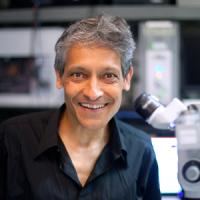ABOUT ANIRUDDHA DAS
Does a Rush of Blood to the Head Help Us to Anticipate?
A mysterious discovery, an unexpected change of blood flow in the brain, could help explain how we prepare for upcoming events and pay attention to what is important.

While scanning a part of the brain important for vision, Aniruddha Das, PhD, stumbled across something strange. His instrument picked up a massive anticipatory rush of blood that he could not explain.
He still can’t. But he believes that this mysterious blood flow may be the key to answering a long-standing question in neuroscience: How do we prepare for events we are anticipating?
An avid cyclist on the streets of Manhattan, Dr. Das knows firsthand how much our survival depends on our ability to anticipate and spot things in advance, from cars and their doors to pedestrians and their dogs. As a neuroscientist, he also knows how little we understand about how the brain motivates us to pay attention to those objects.
“The brain mechanisms responsible for attention and motivation are quite poorly understood,” said Dr. Das. “Understanding the significance of this blood flow could give us an entry point to understanding these subjects.”
An increase in blood flow to a part of the brain is usually thought to be the result of increased neural activity there. As nerve cells perk up, they consume oxygen; that oxygen is then replenished by fresh blood. But when Dr. Das measured electrical activity in the brain region with the blood flow originally picked up by his optical brain scanner, he found no increase. This was a first, and a surprise to the neuroscience community.
“People using this tool assumed that if you saw changes in blood flow in a certain area, it meant there must have been an increase in neural activity there,” said Dr. Das. “That assumption turned out to be wrong in this case.”
His willingness to question assumptions about the tools of neuroscience may stem from his background. As a young child growing up in India, he took apart radios and built motors to understand how they worked; his engineer father told him that you have know how something works before you can feel comfortable using it. Years later, he started tinkering with scientific equipment as a student studying with physicist Charles Townes, best known as the inventor of the laser.
“Because of my background in physics, I do not feel comfortable making a measurement unless I know what exactly my instrument is measuring,” said Dr. Das.
Having uncovered this mystery, he has begun to make some progress in solving it. He first spotted the change in blood flow in animals waiting to play a simple video game. His work since has shown that the flow depends on an animal’s internal brain state. It grows stronger when an animal is kept in anticipation for a longer time or when it expects to do something that triggers strong emotions or leads to a larger reward.
Could this surge in blood be connected to the sharpening of attention a child feels when waiting to open a birthday present or the excitement you feel when expecting to see a close friend after a long absence?
Perhaps. Or perhaps the rush of blood has little to do with the complexities of the mind. “The blood flow we see may simply be a quirk of blood pressure regulation in the brain, like in old buildings with creaky plumbing, where the pressure drops everywhere when someone takes too enthusiastic a shower,” said Dr. Das.
He is excited to find out. “Being uncertain is nerve-wracking, but productive uncertainty is crucial to good science,” he said. “Science would not be interesting if the results were predictable.”
Selected Publications
-
Stimulus-related neuroimaging in task-engaged subjects is best predicted by concurrent spiking.
Lima B, Cardoso MM, Sirotin YB,
J Neurosci.2014 Oct 15
-
The neuroimaging signal is a linear sum of neurally distinct stimulus- and task-related components.
Cardoso MM, Sirotin YB, Lima B, Glushenkova E,
Nat Neurosci.2012 Sep
-
Spatial homogeneity and task-synchrony of the trial-related hemodynamic signal.
Sirotin YB, Cardoso M, Lima B,
Neuroimage.2012 Feb 1
-
What could underlie the trial-related signal? A response to the commentaries by Drs. Kleinschmidt and Muller, and Drs. Handwerker and Bandettini.
Das A, Sirotin YB
Neuroimage.2011 Apr 15
-
Zooming in on mouse vision.
Sirotin YB,
Nat Neurosci.2010 Sep
